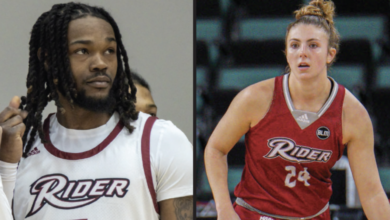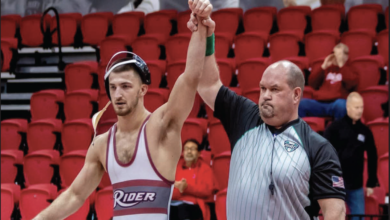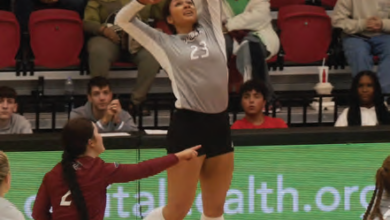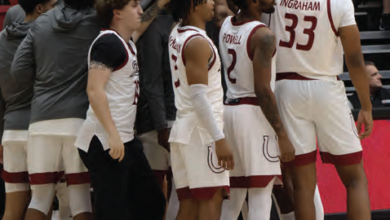
Track and field hopeful for indoor season
By Shaun Chornobroff
College sports are preparing to return to normal, or a new normal to say the least.
College football is back, with even the Big Ten controversially announcing its return to play and plans are being made for the Metro Atlantic Athletic Conference (MAAC) to return to all sports in the winter, including indoor track and field.
Rider’s men’s and women’s indoor track teams will be facing several difficulties this upcoming season and Head Coach Bob Hamer knows that this season will be different, if it is played at all.
“I think there’s a lot of uncertainty,” Hamer said. “I think a lot of the student-athletes and the coaches are very anxious and concerned about the uncertainty. Are we going to have an indoor season? Collectively we think there’s going to be an outdoor season, but we want to have an indoor season.”
Junior sprinter James Green is expecting a season as he does not see why it would be necessary to cancel.
“It would be ridiculous to not give us a season,” Green said. “We are a non-contact sport that could easily continue, although COVID-19 is a concern. Regardless of if we have dual meets, or multiple schools racing spaced out in heats of four rather than eight.”
In the past, the team has gone to Ocean Breeze or the Armory to compete with many other schools. Hamer says the team has been to some of the biggest competitions in the country, but that’s unlikely this year.
Hamer explains that it is more likely that we see dual or tri-meets with local schools or other MAAC schools.
“We’ve been working with Monmouth [University], we already had a dual meet scheduled with them on our schedule this year. Coach [Mike] Nelson has been very forthcoming in the idea that he wants to have multiple opportunities to host smaller meets at his facilities,” Hamer said.
“Normally during the indoor season we go to meets that will have 20-25 teams, sometimes there are upwards of 50-60 teams at an invitational. That’s likely not going to be the case this year, So smaller meets are going to be more of a premium. The bigger challenge is going to be that there aren’t as many facilities as there are outdoor facilities, so there may be situations where teams may be squeezed out of opportunities because they aren’t getting invited or don’t have the connections or aren’t being given the right opportunities from fellow teams in their areas or conferences.” Monmouth University and Manhattan College are the only schools in the MAAC conference with indoor track and field facilities. Hamer also mentioned that the current plan is to still have an indoor championship in March at The Armory in New York. The MAAC indoor track and field championships would have eight men’s programs and nine women’s programs competing together.
“That’s the hope, that we can have the championship we compete in as is, but I know the MAAC is working on alternate scenarios,” Hamer said. “I’m sure they’re looking for every opportunity to minimize the number of athletes that are in a building at a particular time.”
The men’s and women’s teams usually compete in meets at the same time, though Hamer said the championships may be separated by gender this year.
As the teams and schools prepare, practices look especially different from previous years.
Hamer’s practices are now run by events, meaning that sprinters practice with sprinters, hurdlers practice with hurdlers, as is with all of the events the team has. Then it’s broken up into subgroups or “pods” of somewhere between two-to-six people and Hamer said “these are the people they spend all their time with.”
Even though there are many changes, it doesn’t mean there has been any drop-off in intensity. Practices are more intense now than ever before.
“Practices are like track meets now,” Green said. “We are working harder on and off the track. But the crazier part is that the energy and bond is something special. The younger athletes are something to keep an eye on and the returners have a chip on their shoulders. So, practices are no joke.”
These practices have the team as a whole focused to a new extent, even if thoughts of a canceled season persist.
“We are working. We are not listening to all the rumors, we’ve tuned out the distractions and we’re locked in. There’s no uncertainty whatsoever. We will continue to compete in practice and every opportunity that presents itself. We plan to continue to build and do things better than the years before,” Green said.
While track and field have been stuck laying in a bed of uncertainty, men’s basketball has been receiving more information on a potential season. Despite his sport often getting overlooked, Hamer is pleased that basketball is back.
“Basketball definitely helps the rest of us be able to do the things that we need to do to provide the resources that we need for our athletes, so we need to figure out a way to complete basketball successfully, but we should also put equal time and resources into figuring out can we contest the other sports as well,” Hamer said passionately. “I think we owe that to those athletes. It seems that they figured out what their plan is for basketball which is great and I hope it’s successful and I hope they can focus on making sure other sports have those same opportunities.”
Hamer added that “the MAAC is working hard for indoor to make sure that we have an indoor track and field championship and a swimming and diving championship.”
It’s been more than six months since Hamer had to tell his team that the sport they love was being taken away from them. He described it as “a really difficult time.” For Green, it created a sense of determination and hunger. A hunger that he and the rest of his team hopes is quenched in January in a dual-meet against Monmouth University.



